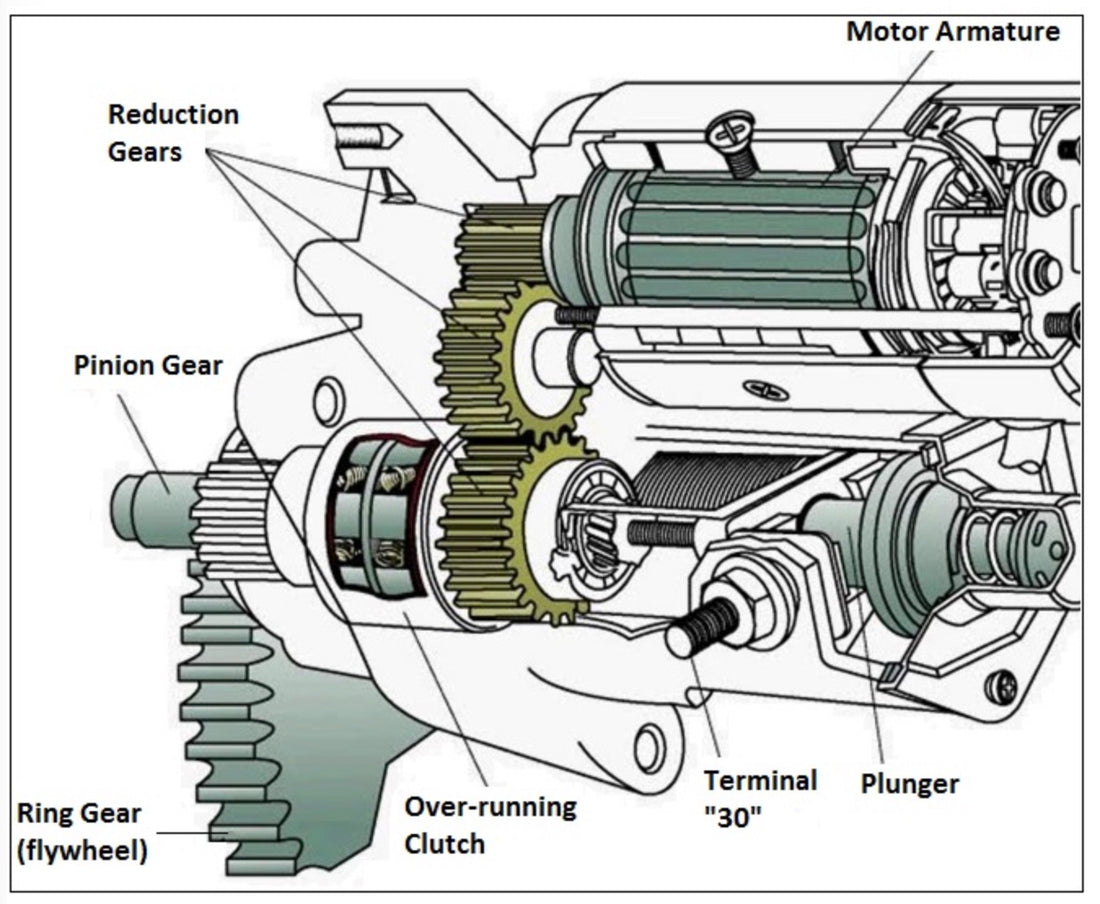What goes on inside your old Lucas starter.
(The Non-Technical explanation)
(The Non-Technical explanation)
First, the cars battery provides electrical energy to the starter through the main battery cable. When you turn the key all the way forward to the start position, the solenoid moves the starter gear into contact with the flywheel gear and then, and only then, the starter motor begins to spin. Since the starter gear and flywheel gear have meshed together, this spinning motion is transferred to the flywheel which is attached to the crank shaft. The starter spins the engine until it begins to run on its own. When you let go of the key, the solenoid then moves the starter gear away from the flywheel gear.


Direct Drive Starter
The starter pinion gear is connected to the armature. The armature contains windings, within a core made of metal laminations, that produce a magnetic field when a voltage is applied via the field brushes to the commutator segments. The armature spins within a set of pole pieces surrounded by the field coils.

When a voltage is applied to the field coils the pole pieces become powerful magnets with alternating north and south poles. The interaction between the magnetic forces in the armature and that of the pole pieces produces a spinning motion in the armature. A spinning motion so powerful that it is capable of spinning the engines crankshaft until the engine begins to run on its own. **Keep in mind this is just a thumbnail sketch of the internal workings of a starter. Some things have been simplified and others omitted in order to make it short and to the point.
So what are the limitations of the direct drive starter?
Starters can be run for only a few seconds at a time before they begin to overheat.
During cranking the starter is converting energy from the battery to into a huge amount of mechanical motion. This process produces very high temperatures inside the starter very quickly.
Unlike alternators, direct drive starters have no means of cooling, so cranking for more than a few seconds can damage starter components. In addition, the pinion gear only spins as fast as the armature. Many new vehicles have a timer built into the starting system that will not allow the starter to be engaged for more than about 10 seconds at a time.
High Torque, Gear Reduction Starters - Improvements in starter design.

High Torque Gear Reduction Starter
While it is correct to say that the basic principles of the starter motor are the same today as they were when the first starter was designed, many specifics of starter design have changed considerably. For instance, the pole pieces, which become powerful magnets when electricity flows through the field coils that are wrapped around them, have been replaced in most modern starters with permanent magnets.
While it is correct to say that the basic principles of the starter motor are the same today as they were when the first starter was designed, many specifics of starter design have changed considerably. For instance, the pole pieces, which become powerful magnets when electricity flows through the field coils that are wrapped around them, have been replaced in most modern starters with permanent magnets.
Since the energy required to magnetize the pole pieces is not needed, the high torque starter uses less power from the battery, making it more efficient. This is the main reason the direct drive design shown in first example above has been replaced with gear reduction drive designs.

The starter pictured above is an example of one of our high torque gear reduction starters. The advantage of this design is that it allows for a smaller, lighter starter to produce greater torque, as compared to the earlier direct drive starters, while using less energy from the battery. Simply stated, gear reduction starters use gears to reduce the speed of a higher-speed electric motor in order to extract more torque at the flywheel end of the starter. Notice the pinion gear is no longer connected to the armature shaft. In the high torque starter design, the armature spins about 4 times faster than the pinion gear, whereas in a direct drive type, the pinion gear turned at the same speed as the armature.
We hope you found this bare-bones explanation helpful in your understanding of the starter motor and the benefits of upgrading to a BritishStarters.com starter.







